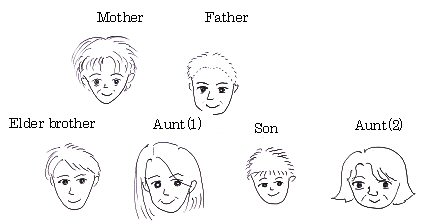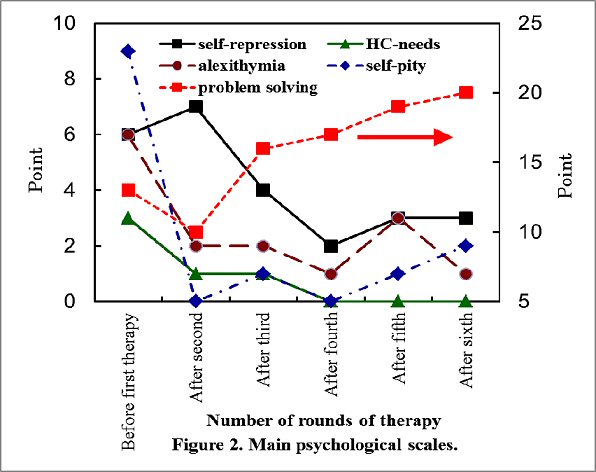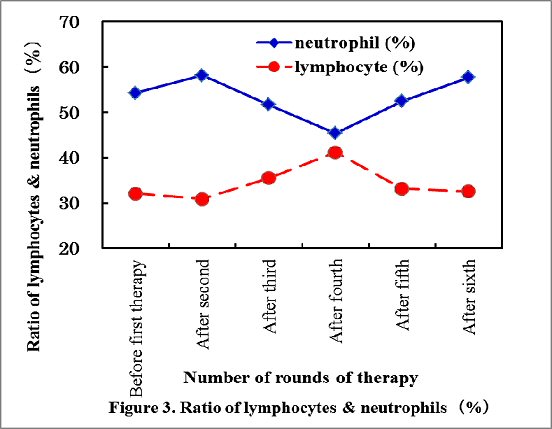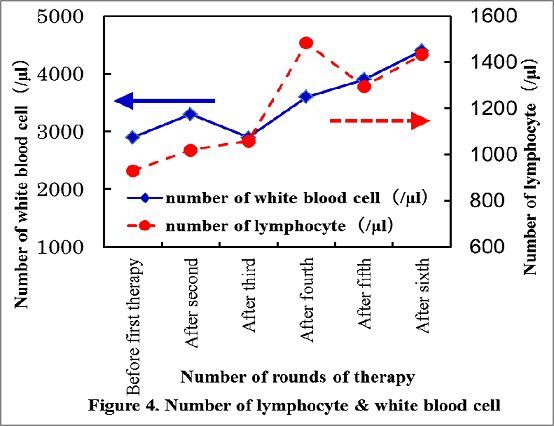International Journal of Structured Assocoation Technique No.5 pp.1-6
Short Communication
Gene Expression with Chemical Modification Induced by SAT Imagery Therapy
Kei-Ichiro Kobayashi*, and Tsunetsugu Munakata**
Counseling Room "Vivid Life" *,
Chair, Institute of Health Behavioral Science, Emeritus Professor, University of Tsukuba **
Abstract
Whole genome analysis of a female patient with thyroid gland cancer was carried out using microarrays. During 2 rounds of structured association technique (SAT) imagery therapy, many genes including tumor-suppressor genes were shown in the "on-off" condition. Simultaneously, the methylation and acetylation reactions were also confirmed to occur. Our results showed that the SAT imagery therapy regulated the expression of genes, without causing any side effect, in accordance with the "on-off" mechanism. Moreover, during the 6 courses of the SAT imagery therapy, the number of white blood cell and lymphocyte increased to 〜150%.
Keywords
cancer, methylation, microarray, whole genome, SAT imagery therapy
Address for Correspondence
Kei-Ichiro Kobayashi
Counseling Room "Vivid Life" *,
Royal-Plaza-Fuchu-303, 1-4-3 Kotobuki-Cho, Fuchu-City, Tokyo, 183-0056 Japan
Tel/Fax: 042-362-8199
E-mail Address: vivid-life@tea.ocn.ne.jp
1. Introduction
Gene expression is known to be influenced by the environment; this is known as epigenetics1). Methylation and acetylation have been reported to be the main mechanisms underlying the epigenetic regulation of genes2).
SAT imagery therapy for patients with various types of cancer has been found to lead to an increase in the expression of the tumor-suppressor genes such as p53, RB, RUNX3, and BRCA2, by more than 200%. These findings indicate that the change of subconscious stress images is effective in regulating tumor-suppressor gene expression3,4). However, it remains unclear whether the regulation of gene expression by SAT imagery therapy involves methylation and acetylation processes.
Accordingly, in this study, a whole genome analysis of a female patient with thyroid cancer was performed using a microarray approach. In this analysis, we could observe not only the up- and down-regulation of many genes, including tumor-suppressor genes, in response to SAT imagery therapy, but also found that methylation and acetylation reactions were involved in this "on-off" process. Our findings strongly suggest that the same epigenetic mechanisms are involved in the regulation of gene expression through structured association technique (SAT) imagery therapy, and these provide valuable pointers for further investigation.
2. Methods
2.1 Application of SAT imagery therapy to the cancer patient
Having explained the scientific grounds of SAT imagery therapy and some precedents to cancer patients who wished to receive this treatment, we also provided the patients with information on the assessment of genes. After obtaining their written consent, we started the therapy.
All the therapy and evaluations were carried out with the permission of the ethics committee of School of comprehensive Human Sciences, University of Tsukuba.
2.2 Personal background and medical history of the patient
The subject of this study was a 32-years-old female patient who had been diagnosed with thyroid gland cancer in June 2008. At that time, metastasis to the lymph nodes was also identified. Her thyroid gland was surgically removed. In October 2008, she received one course of X-ray radiation therapy. In December 2008, she started SAT imagery therapy. The main theme throughout her SAT imagery therapy was the relationships with her supervisor and her mother.
She had married at 20 years of age, and divorced her husband 2 years later due to his marital unfaithfulness. She raised their son by herself, who was 3-years-old when they divorced. She had had a good relationship with the wife of her president (president of the corporation she worked for); however, when this president's wife became her supervisor, she became extremely depressed, with ambivalent emotions for her supervisor.
She underwent 6 courses of SAT imagery therapy at the O-clinic in Tokyo metropolitan.
2.3 Physiological data
Since the pre-intervention data were to be used as base-line data, we obtained blood from the patient before the first round of SAT imagery therapy, and measured the blood components and expression levels of tumor-suppressor genes (p53, RB, RUNX3, BRCA2) therein. From the second therapy onward, we obtained blood samples after each round of therapy. The whole genome expression measurement was carried out at DNA Chip Research Inc.; the criteria for the "on-off" status of genes were set at 150% and 67% for "on" and "off," respectively. The details of this procedure have been reported in a previous paper5).
3. Results
3.1 Progress of therapy
Six rounds of SAT therapy were performed with this client. In the first and the second rounds of the therapy, physical signs such as a stiff neck and her anxiety related to her new job she wanted to start in near future were treated; at this time, ideal images had been found for not only her parents, but also for unborn persons, such as an elder brother, a child, and 2 paternal aunts (Figure 1). During the third round of therapy, unconscious anger, which is common to patients with thyroid cancer, was treated. Through modification of the image of her maternal ancestors, she realized her script to be expressed as "wishing to do everything herself in isolation", which she had done repeatedly throughout her life. A new script was instituted for her, viz., "depend on other people and make use of other people". During the fifth round of therapy, she recognized the existence of her own elder sister, who was one of the triplets, from the physical signs on her neck and shoulder. Consequently, by applying a photograph of a famous woman as an ideal image, she succeeded in controlling her physical signs. During the sixth and last round of therapy, we reviewed her previous 5 sessions and confirmed the improvement of her data and emotional well-being, and then the therapy was concluded.

Figure 1. Ideal images found for parents and unborn members such as an elder brother,
a child and 2 paternal aunts
3.2 Psychological scales
Figure 2 shows the change in her behavioral traits involving the stress response. Remarkable improvement was observed in the self-pity type of behavior trait (reduction from 9 points to 2 points) and the problem-solving type of behavior trait (increase from 10-13 points to 16-20 points). The self-repression behavior trait and the alexithymia characteristic also showed noticeable improvement. The points involving self-denial and PTSS scales had disappeared.

3.3 Component of White blood cell counts
Unconscious stress images are reflected in the white blood cell counts, especially in the ratio of lymphocytes and neutrophils. Figure 3 shows the appropriate progress in this ratio through 6 rounds of therapy. The number of lymphocytes, after being decreased by X-ray radiation therapy, increased markedly from 930/μl (before the first round of therapy) to 1300-1500/μl (after the 4th -6th rounds of therapy), as shown in Figure 4.


3.4 Whole genome analysis
It has been confirmed that, among 41,000 human genes, 27,636 different genes are found at the tips of chromosome. During the first and second round of therapy, the expression of 3,495 genes was found to change; of these, the expression of 1,251 genes was increased, and that of 2,244 genes decreased.
Of the tumor-suppressor genes, the expression of 124 genes changed. In particular, the expression of 63 of these genes, including TP53, RUNX2, PML, RB1, etc., was increased (RB1 increased 1.28 times), while that of 61 genes, including SU212, TUSC2, etc., were decreased. PML is known to be a tumor-suppressor gene that plays a role in leukemia. Gene ontology analysis for the biological processes involved in the results of this whole genome scan revealed that the genes differentially regulated were typically involved in chromatin modification, such as methylation and acetylation (FDR<0.0001).
4. Discussion
In this study, we show that SAT imagery therapy effects the regulation of tumor-suppressor genes through chemical modification of the DNA, such as methylation and acetylation processes, for the first time, suggesting the effectiveness of SAT imagery therapy in mediating genetic treatment.
Unexpected side effects are generally observed with pharmaceutical treatments; on the contrary, no side effects occur with SAT imagery therapy. Although only 1 case has been investigated here, our results indicated that the differential regulation of genes found with SAT imagery therapy involves the same regulatory mechanisms, i.e., methylation and acetylation, which are commonly involved in epigenetic regulation of gene expression.
Consequently, it is important to analyze the biological and chemical processes involved in the differential regulation of genes through SAT imagery therapy in more detail.
References
- Lipton B.H.: The Biology of Belief, Hay House, California 80-118, Revised edition (2008)
- Yoichi Shinkai (Ed.): Histone post-translational modifications and their biological function, Experimental Medicine Vol. 26, No. 9, 1322-1326 (2008)
- Kobayashi, K.-I., Hashimoto, S., Hayashi, T., Sakamoto, S., Hori, M., Obitsu, R., Murakami, K. Munakata, T.: Treatment of Patients With Cancer for Stressful Emotion Transmitted from Ancestry by Using Genetic and Immunologic Data as Barometers. International Journal of Structured Association Technique, Electronic Journal of Social Skill, Counseling and Imagery Therapy, 1: 36-58 (2007)
- Munakata, T., Kobayashi, K.-I.: SAT Imagery Therapy for Cancer, Shunju-sha, Tokyo, 44-68 (2007)
- Kobayashi, K.-I., Munakata, T.: On-Off of Entire-Gene through Chromatin Modification and Remarkable Increase in NK-Cell Activity. Journal of Health Counseling, 17:31-39 (2011)